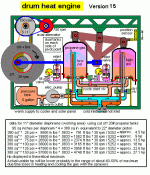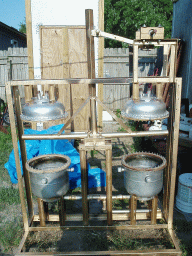|
Solar Hot Water Powered Drum Engines |
|
55 gal or 2-# propane tank drum based Solar Hot water powered engine / battery charger This engine system is based on a Newcomen steam engine that has been converted to operate on the Rakine cycle. There is no steam used, only hot and cool water. The drum(s) contain water and propane gas. It is the large expansion versus temperature ratios of the propane gas that is used as the agent to create power in the engines. The basic theory of operation: Below is a series from one of the first simple designs using an actual cut-off 55 gal metal drum to more complicated and powerful systems that use multiple 20# propane tanks that are recycled and converted for use. All these designs use diaphrams as the movable part of the pressure system. |
||||||
|
The 55 gal. drum contains water and propane gas. The top of the drum has a large diaphram piston that moves up and down depending on the psi of the propane. The psi of the propane is changed by simply spraying hot or cold water through it. The system is self regulating and provides it’s own pumping capabilities. Using only a 4 psi change operating at 30 rpm would put out approx .75 hp maximum. A standard metal barrel can only hold about 4 psi maximum. |
The uses 4 20# propane tanks and a maximum of 30 psi as a differential pressure. At 30 rpm this setup would theoretically be capable of over 11 hp output maximum power. Actual output would probably be about 1/4 of that at most. This setup has a better and more reliable pumping system than the one above. It is shown with an electric start pump but could also use a manual pump to start the system. It uses electric solenoid valves to control the flow of water to the sprayers . This will allow the valve timing to be setup and adjusted.
|
These versions are high power types using a maximum of 100 or 150 psi gas pressure. I have inverted the drums in these versions also and all the plumbing will go through the piston plates themselves. Here the drums will go up and down as the engine runs as the piston plates are mounted solidly to the frame |
||||
|
This is a basic control circuit for the last system above. It’s mainly mechanical and uses reed switches for the sensor and control switching. The 110 vac to the control valves is switched on and off by use of optically isolated solid state relays. It will control the timing of all the equalization valve, and all the hot and cold sprayer valves. |
This is a simple modification to the previous drum engines where there is |
This setup has had the plumbing setup around to where the propane gas is controlled instead of the water flow between the tanks. The gas is vented into the tank through a heating coil setup inside the tank or drum itself. As the gas heats up the pressure rises causing both the diaphram to move upward created power through the crossbeam and crank arm to the wheel and pumping the water out of the drum through the solar panel into the other drum. This causes the propane the other drum to feed into the external cooling coils dropping the pressure. At the same time the compressor pump end is putting propane into the pressure tank in start the next cycle. |
||||
|
|
|
|
||||









